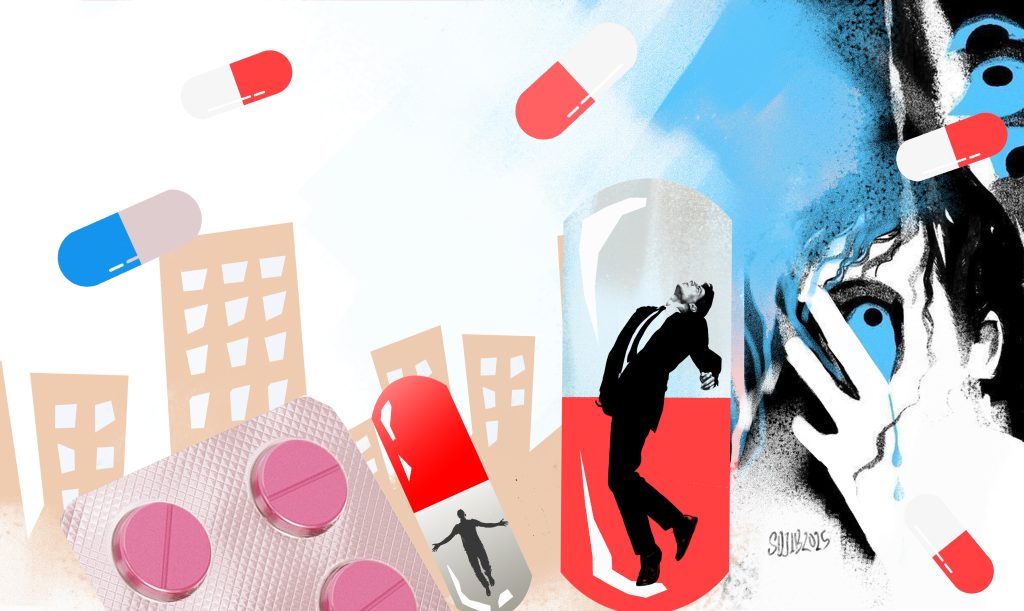Just two decades ago, antidepressants were barely known in Bangladesh. Today, Dhaka’s pharmacies are stacked with boxes of little white pills that promise relief from sadness, anxiety and the suffocating depths of depression. For many, these medications- sertraline, escitalopram, fluoxetine- are now the first line of treatment when the darkness feels unbearable.
Antidepressants have quietly woven themselves into the mental health landscape of urban Bangladesh. But as their use grows, so do questions about their effectiveness, side effects, and the long-term costs of relying on them. For every story of relief, there is another of frustration or unintended consequences.
At their best, these drugs can be lifesaving. By adjusting levels of neurotransmitters like serotonin and norepinephrine, they help regulate mood, sleep, and thought patterns. For someone drowning in depression or consumed by obsessive thoughts, antidepressants can “turn down the volume” of despair. Patients often describe feeling calmer, more focused, and able to function again.
“Since the first day I took it, the haziness and the overthinking disappeared. I felt way more focused; it was a total game-changer for me,” said Mashfiq, a 20-year-old student living in Savar who was previously suffering from frequent bouts of depression. For doctors, such medications provide a basic but vital response in a country where therapy and counselling remain scarce and unaffordable for most.
The change is visible in clinics too. “In the last decade, we are seeing more young people coming in with depression, anxiety, and related conditions. Academic pressure, economic stress, social isolation and digitalisation are all playing a role here,” said Dr. Arman Ibne Haq, an associate professor of psychiatry in Bangladesh Medical College.
Yet the relief is not always permanent. Many patients say the benefits fade after weeks or months, leading to higher doses or constant drug-switching. Sarah, a 21-year-old student, described the cycle: “My mood improved when I started, but after a few weeks it wasn’t working as well. I had to increase the dosage.”
Her experience echoes what many others report: an exhausting search for stability that never fully arrives.
Then comes the problem of stopping. While antidepressants are not addictive in the way opioids or nicotine are, sudden withdrawal can unleash a storm of side effects, brain zaps, nausea, insomnia, and irritability. In Bangladesh, where follow-up care is limited and cost often forces patients to quit abruptly, the fallout can be devastating.
“It was horrible when I stopped after six months,” recalled Mashfiq. “I’d get brain zaps, and every time I closed my eyes, my head spun. The overthinking came back too.”
Beyond the withdrawal, side effects of antidepressants can range from weight gain to sexual dysfunction to even emotional blunting. “I do feel emotionally numb,” Sarah admitted. “I think I even got meaner to people than before.” Relief, for some, comes at the price of muted joy.
That gap between suppressing pain and addressing its roots worries professionals. “Medication was always meant to be only part of the treatment,” said the psychiatrist. “It should be combined with therapy, lifestyle adjustments, and social support. Otherwise, we are just medicating symptoms, not solving actual problems.”
The larger question lingers: Are we medicalising sadness while ignoring the social roots of distress—loneliness, toxic family environments, relentless academic competition, and economic pressure? By focusing only on brain chemistry, do we risk overlooking the human context of suffering?
“People in Bangladesh are becoming more aware and caring about their mental health and that is a welcome change,” said the doctor. “Still, the actual treatments remain far from accessible. We have a long way to go here.”
Antidepressants are neither miracle cures nor villains. They can buy time, restore function, and even save lives. But pills alone cannot heal the deeper wounds of the mind or society. In Bangladesh, where counselling and therapy remain scarce, they may serve as the first bridge to care. But it is a bridge that must be crossed with caution, compassion, and broader access to real mental health support. True wellness will require not just medication, but also empathy, community, and a commitment to treating the whole person.


